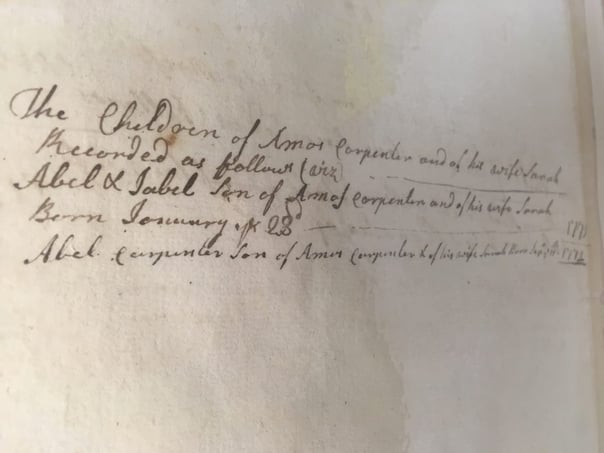A recent example of using transcribed records reminded me that many genealogists who wrote turn of the century family histories were using the same original records that were later transcribed – and thus the records that are often used today. Sometimes the genealogist read the records better than the transcriber.
Rehoboth Vital Records, as transcribed by James Newell Arnold in his 1897 publication, list the following children of Amos and Sarah Carpenter, taken from Original volume 3, page 192, shown above left.
 These would appear to show that they had twins – Abel and Isabel – in 1771. The child Abel likely died young, as another Abel soon followed in 1772. However, Amos B. Carpenter’s 1901 genealogy (above) on the Carpenter family in Rehoboth reads differently.
These would appear to show that they had twins – Abel and Isabel – in 1771. The child Abel likely died young, as another Abel soon followed in 1772. However, Amos B. Carpenter’s 1901 genealogy (above) on the Carpenter family in Rehoboth reads differently.
Which source is correct? the “documented” 1897 transcription of Rehoboth Vital Records or the “undocumented” 1901 Carpenter genealogy?
This indicates “Jabel” Carpenter as a man with a later residence in Cumberland, Rhode Island, where a man with that name is documented in the 1800 census.
Which source is correct? the “documented” 1897 transcription of Rehoboth Vital Records or the “undocumented” 1901 Carpenter genealogy? As these genealogies took years to produce, Amos B. Carpenter probably did not use Arnold’s transcription and so went right to the same source, the vital records kept with the Rehoboth Town Clerk, where they remain today, and not on microfilm, since most of us today now use the 1901 transcription. My colleague Nancy Bernard asked the Rehoboth Town Clerk to take a picture of the original record:
The record is Jabel, and it should read “Sons of Amos Carpenter …” but only says “Son.” It’s easy to see how James N. Arnold could have misread this J for an I and put in Isabel instead, thus creating a non-existent twin daughter. Also, Arnold was transcribing record by record, largely not making any attempt to connect these people in later records. Amos B. Carpenter, however, was writing a family history, and clearly had some correspondence to show that Jabel later lived in Cumberland, Rhode Island; he was expecting the record to be a boy’s name, and so was able to read Jabel’s name correctly!
Jabel Carpenter married Chloe Fuller and had three children, including a son, Pardon Carpenter (1794–1858) of Cumberland; their families will be treated in a forthcoming Newbury Street Press book.
Share this:
About Christopher C. Child
Chris Child has worked for various departments at NEHGS since 1997 and became a full-time employee in July 2003. He has been a member of NEHGS since the age of eleven. He has written several articles in American Ancestors, The New England Historical and Genealogical Register, and The Mayflower Descendant. He is the co-editor of The Ancestry of Catherine Middleton (NEHGS, 2011), co-author of The Descendants of Judge John Lowell of Newburyport, Massachusetts (Newbury Street Press, 2011) and Ancestors and Descendants of George Rufus and Alice Nelson Pratt (Newbury Street Press, 2013), and author of The Nelson Family of Rowley, Massachusetts (Newbury Street Press, 2014). Chris holds a B.A. in history from Drew University in Madison, New Jersey.View all posts by Christopher C. Child →

